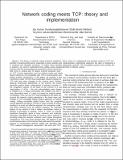| dc.contributor.author | Sundararajan, Jay Kumar | |
| dc.contributor.author | Shah, Devavrat | |
| dc.contributor.author | Medard, Muriel | |
| dc.contributor.author | Jakubczak, Szymon Kazimierz | |
| dc.contributor.author | Mitzenmacher, Michael | |
| dc.contributor.author | Barros, Joao | |
| dc.date.accessioned | 2012-11-26T19:57:40Z | |
| dc.date.available | 2012-11-26T19:57:40Z | |
| dc.date.issued | 2011-01 | |
| dc.date.submitted | 2010-03 | |
| dc.identifier.issn | 0018-9219 | |
| dc.identifier.issn | 1558-2256 | |
| dc.identifier.uri | http://hdl.handle.net/1721.1/75026 | |
| dc.description.abstract | The theory of network coding promises significant benefits in network performance, especially in lossy networks and in multicast and multipath scenarios. To realize these benefits in practice, we need to understand how coding across packets interacts with the acknowledgment (ACK)-based flow control mechanism that forms a central part of today's Internet protocols such as transmission control protocol (TCP). Current approaches such as rateless codes and batch-based coding are not compatible with TCP's retransmission and sliding-window mechanisms. In this paper, we propose a new mechanism called TCP/NC that incorporates network coding into TCP with only minor changes to the protocol stack, thereby allowing incremental deployment. In our scheme, the source transmits random linear combinations of packets currently in the congestion window. At the heart of our scheme is a new interpretation of ACKs-the sink acknowledges every degree of freedom (i.e., a linear combination that reveals one unit of new information) even if it does not reveal an original packet immediately. Thus, our new TCP ACK rule takes into account the network coding operations in the lower layer and enables a TCP-compatible sliding-window approach to network coding. Coding essentially masks losses from the congestion control algorithm and allows TCP/NC to react smoothly to losses, resulting in a novel and effective approach for congestion control over lossy networks such as wireless networks. An important feature of our solution is that it allows intermediate nodes to perform re-encoding of packets, which is known to provide significant throughput gains in lossy networks and multicast scenarios. Simulations show that our scheme, with or without re-encoding inside the network, achieves much higher throughput compared to TCP over lossy wireless links. We present a real-world implementation of this protocol that addresses the practical aspects of incorporating network coding and decoding with TCP's wind ow management mechanism. We work with TCP-Reno, which is a widespread and practical variant of TCP. Our implementation significantly advances the goal of designing a deployable, general, TCP-compatible protocol that provides the benefits of network coding. | en_US |
| dc.description.sponsorship | National Science Foundation (U.S.) (Grant CNS-0627021) | en_US |
| dc.description.sponsorship | National Science Foundation (U.S.) (Grant CNS-0721491) | en_US |
| dc.description.sponsorship | National Science Foundation (U.S.) (Grant CCF-0915922) | en_US |
| dc.description.sponsorship | United States. Defense Advanced Research Projects Agency (Subcontract 18870740-37362-C) | en_US |
| dc.description.sponsorship | United States. Defense Advanced Research Projects Agency (Subcontract 060786) | en_US |
| dc.description.sponsorship | United States. Defense Advanced Research Projects Agency (Subcontract 069145) | en_US |
| dc.description.sponsorship | United States. Defense Advanced Research Projects Agency (Contract N66001-06-C-2020) | en_US |
| dc.description.sponsorship | Space and Naval Warfare Systems Center San Diego (U.S.) (Contract N66001- 08-C-2013) | en_US |
| dc.language.iso | en_US | |
| dc.publisher | Institute of Electrical and Electronics Engineers (IEEE) | en_US |
| dc.relation.isversionof | http://dx.doi.org/10.1109/JPROC.2010.2093850 | en_US |
| dc.rights | Creative Commons Attribution-Noncommercial-Share Alike 3.0 | en_US |
| dc.rights.uri | http://creativecommons.org/licenses/by-nc-sa/3.0/ | en_US |
| dc.source | MIT web domain | en_US |
| dc.title | Network Coding Meets TCP: Theory and Implementation | en_US |
| dc.type | Article | en_US |
| dc.identifier.citation | Sundararajan, Jay Kumar et al. “Network Coding Meets TCP: Theory and Implementation.” Proceedings of the IEEE 99.3 (2011): 490–512. | en_US |
| dc.contributor.department | Massachusetts Institute of Technology. Department of Electrical Engineering and Computer Science | en_US |
| dc.contributor.mitauthor | Shah, Devavrat | |
| dc.contributor.mitauthor | Medard, Muriel | |
| dc.contributor.mitauthor | Jakubczak, Szymon Kazimierz | |
| dc.contributor.mitauthor | Sundararajan, Jay Kumar | |
| dc.relation.journal | Proceedings of the IEEE | en_US |
| dc.eprint.version | Author's final manuscript | en_US |
| dc.type.uri | http://purl.org/eprint/type/JournalArticle | en_US |
| eprint.status | http://purl.org/eprint/status/PeerReviewed | en_US |
| dspace.orderedauthors | Sundararajan, Jay Kumar; Shah, Devavrat; Médard, Muriel; Jakubczak, Szymon; Mitzenmacher, Michael; Barros, João | en |
| dc.identifier.orcid | https://orcid.org/0000-0003-4059-407X | |
| dc.identifier.orcid | https://orcid.org/0000-0003-0737-3259 | |
| mit.license | OPEN_ACCESS_POLICY | en_US |
| mit.metadata.status | Complete | |
